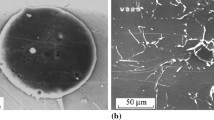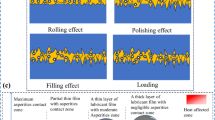Abstract
The binary system of vanadium and nitrogen offers promising phases in order to enhance the tribological properties of common hard coatings, owing to their ability to form lubricious oxides, often also referred to as Magnéli phases, at elevated temperatures. The aim of this work is to characterize VN coatings prepared by reactive unbalanced magnetron sputtering, and to verify the new concept of solid/liquid oxide lubrication. Oxidation of the coatings and possible melting of the oxides were investigated by dynamic Thermo-Gravimetric Analysis (TGA) and Differential Scanning Calorimetry (DSC) up to 900 °C in air. On heating the coating samples, exothermal reactions appeared during the DSC measurements indicating oxidation in the temperature range of 500–650 °C. Subsequently, endothermal melting reactions were observed between 650 and 850 °C. To investigate the effect of oxide formation and melting, dry sliding experiments against alumina and austenitic stainless steel balls were performed using a ball-on-disc tribometer in the temperature range between 25 °C and 700 °C. For all coatings evaluated, a significant decrease of the friction coefficient at temperatures above 500 °C was observed compared to room temperature. Additionally, oxide phases were identified by X-ray Diffraction (XRD) after DSC and tribometer testing. Finally, it can be concluded that the lubricious oxide concept should strongly contribute to the reduction of friction for future machining applications.
Similar content being viewed by others
References
S. PalDey and S. C. Deevi, Mat. Sci. Eng. A 342 (2003) 58.
S. Hogmark, S. Jacobson and M. Larsson, Wear 246 (2000) 20.
H. A. Jehn, Surf. Coat. Technol. 131 (2000) 433.
V. Derflinger, H. Bra¨ ndle and H. Zimmermann, Surf. Coat. Technol. 113 (1999) 286.
C. Mitterer, F. Holler, F. U¨ stel and D. Heim, Surf. Coat. Technol. 125 (2000) 233.
D. G. Teer, Wear 251 (2001) 1068.
J. M. Carrapichano, J. R. Gomes and R. F. Silva, Wear 253 (2002) 1070.
B. Navinsek, P. Panjan, M. Cekada and D. T. Quinto, Surf. Coat. Technol. 154 (2002) 194.
M. Stoiber, E. Badisch, C. Lugmair and C. Mitterer, Surf. Coat. Technol. 163–164 (2003) 451.
K. Holmberg and A. Matthews, Coatings Tribology—Properties, Techniques and Applications in Surface Engineering. Elsevier Tribology Series 28 (Elsevier, Amsterdam, 1994).
O. Storz, H. Gasthuber and M. Woydt, Suf. Coat. Technol. 140 (2001) 76.
A. Magne´li, Acta Crystallogr. 6 (1953) 495.
E. Lugscheider, S. Ba¨ rwulf and C. Barimani, Surf. Coat. Technol. 120–121 (1999) 458.
A. Erdemir, Tribol. Lett. 8 (2000), 97
M. Woydt, A. Skopp, I. Do¨ rfel and K. Witke, Wear 218 (1998) 84.
P. H. Mayrhofer, P. E. Hovsepian, C. Mitterer and W.-D. Mu¨ nz, Surf. Coat. Technol. 177–178 (2004) 341.
P. Losbichler and C. Mitterer, Surf. Coat. Technol. 97 (1997) 568.
P. Losbichler, C. Mitterer, P. N. Gibson, W. Gissler, F. Hofer and P. Warbichler, Surf. Coat. Technol. 94/95 (1997) 297.
A. Brenner and S. Senderoff, J. Res. 42(2) (1949) 105.
J. D. Wilcock, and D. S. Campbell, Thin Solid Films 3 (1969) 3.
P. H. Mayrhofer and C. Mitterer, Surf. Coat. Technol. 133–134 (2000) 131.
B. D. Cullity, Elements of X-ray Diffraction (Addison-Wesley, Reading, Massachusetts, 1967).
E. Badisch, C. Mitterer, P. H. Mayrhofer, G. Mori, R. J. Bakker, J. Brenner and H. Sto¨ ri, Thin Solid Films, 460 (2004) 125.
E. Badisch, G. A. Fontalvo, M. Stoiber and C. Mitterer, Surf. Coat, Technol. 163–164 (2003) 585.
E. Badisch and C. Mitterer, in: Proc. 10th Nordic Symposium on Tribology, KTH, Stockholm, 2002
P. H. Mayrhofer, G. Tischler and C. Mitterer, Surf. Coat. Technol. 142–144 (2001) 78.
W. Gulbinski, T. Suszko, W. Sienicki and B. Warcholinski, Wear 254 (2003) 129.
N. N. Greenwood and A. Earnshaw, Chemistry of the Elements, 2nd ed. (Butterworth-Heinemann, Oxford, 1997).
Y. Ningyi, L. Jinuha and L. Chenglu, App. Surf. Sci. 191 (2002)
Author information
Authors and Affiliations
Rights and permissions
About this article
Cite this article
Gassner, G., Mayrhofer, P., Kutschej, K. et al. A New Low Friction Concept for High Temperatures: Lubricious Oxide Formation on Sputtered VN Coatings. Tribology Letters 17, 751–756 (2004). https://doi.org/10.1007/s11249-004-8083-z
Issue Date:
DOI: https://doi.org/10.1007/s11249-004-8083-z




